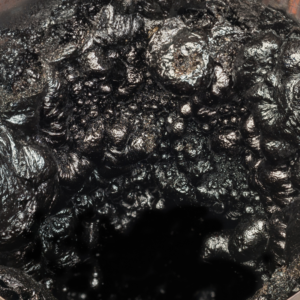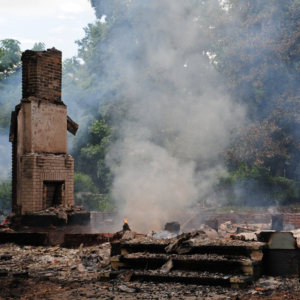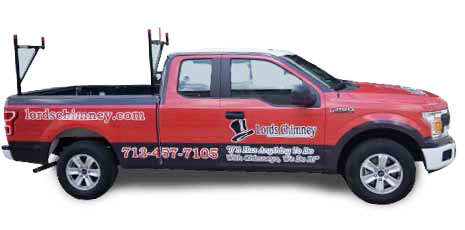If you’ve ever noticed any gummy-looking black stuff in your chimney, chances are it’s creosote. This dark residue is a byproduct of burning wood and it sticks to the inner walls of chimneys. It can be either flaky, shiny, or sticky.
And since creosote forms through burning wood, it is naturally prone to catching on fire. As such, the Chimney Safety Institute of America (CSIA) highlights its high combustibility as a primary safety concern.
Does Creosote Increase the Risk of a Chimney Fire?
Yes! Creosote is a combustible byproduct that can easily catch fire. And once it ignites, it can quickly spread through the chimney, causing the liner to break down and the masonry to crumble and crack. This means any future fires you light will be more prone to escape the chimney walls and enter your home.
 Creosote can also accumulate until it clogs the flue. This blocks the free flow of gases and smoke causing problems with drafting and airflow to develop. This hinders efficiency levels, and it puts you more at risk of being exposed to hazardous fumes, like smoke from your fires or even carbon monoxide – a deadly and extremely hard-to-detect gas.
Creosote can also accumulate until it clogs the flue. This blocks the free flow of gases and smoke causing problems with drafting and airflow to develop. This hinders efficiency levels, and it puts you more at risk of being exposed to hazardous fumes, like smoke from your fires or even carbon monoxide – a deadly and extremely hard-to-detect gas.
Considering the health and safety hazards that creosote poses, regular chimney sweepings become a critical obligation. Professional chimney sweeps have the right equipment to assess any chimney’s condition and address creosote buildup before it becomes a problem.
How To Prevent Creosote Buildup
While creosote isn’t unavoidable, there are ways to effectively reduce accumulation in your flue:
- Schedule Annual Chimney Inspections: It’s important to have a CSIA certified chimney sweep inspect your chimney once per year – before the fall burning season. This is where buildup can be spotted, along with any damages that need to be repaired. Your sweep can also note whether you’ve already experienced a chimney fire.
- Don’t Neglect Sweepings: Regular service is the best way to prevent creosote buildup. If your sweep notes excess creosote deposits during their inspection, be sure to get a follow-up sweeping scheduled as soon as possible. Experts have the proper tools and can remove any buildup in your chimney walls or flue that boosts the chances of experiencing a chimney fire.
- Burn Dry & Well-Seasoned Firewood: Be sure to only burn the correct type of wood in your system. Consider sourcing properly seasoned firewood and make sure it is sufficiently dried out before you toss it in the fireplace. If you put wet, unseasoned wood in your fireplace, you risk producing more residue that will eventually stick to chimney walls, greatly increasing your risk of experiencing a chimney fire.
- Maintain Your Chimney Liner: Ensure that your chimney liner is in good shape and that the chimney is lined correctly. Properly installing a chimney liner improves its performance, but if the liner has been installed incorrectly, it will malfunction and even cause a bigger creosote problem. It can be confusing to determine whether your chimney liner is working correctly, so you it’s always best to rely on the eyes and knowledge of a pro.
- Ensure Proper Chimney Airflow: Whenever you use your fireplace and chimney, be sure the structure gets enough air. Good draft helps fires burn at hotter temperatures, minimizing creosote production in the process. Be sure your damper is open wide enough, took, and get your inspection booked to ensure no blockages are present.
What Are the Signs of a Chimney Fire?
Most chimney fires move slowly and don’t produce a lot of noise, which means you may have had one without noticing. The CSIA identifies the following signs that your chimney could have survived fire before:
 Black or dark-brown byproducts in chimney walls or fireplace
Black or dark-brown byproducts in chimney walls or fireplace- Honeycombed or puffy creosote
- Exterior masonry cracks
- Discoloration in the chimney cap
- Damage to the roofing material due to hot byproducts
- Warped damper metal
- Heat-damaged TV antenna
- Smoke escaping in areas other than the chimney, particularly through tile liners
- Cracked and missing flue tiles
If you do notice that a chimney fire is currently occurring, exit the home immediately and get in touch with your local fire department as soon as possible. In addition, as you are leaving your home, the CSIA suggests closing the door behind you if you can. The goal is to prevent any more air from feeding the flames until the fire department arrives.
Invest in Professional Sweeping Services With Us Today
Even if you believe that your chimney is functioning correctly, there could be hazards hiding away, ready to cause issues. Scheduling a chimney inspection is one way to gain peace of mind, during which we can determine if you need a sweeping.
Creosote is a dangerous byproduct that you might fail to notice immediately. This material is combustible and can cause health and fire hazards in your home. To effectively avoid this issue, we suggest getting in touch with one of our CSIA certified chimney sweeping experts to inspect and clean your chimney. Schedule an inspection today!

